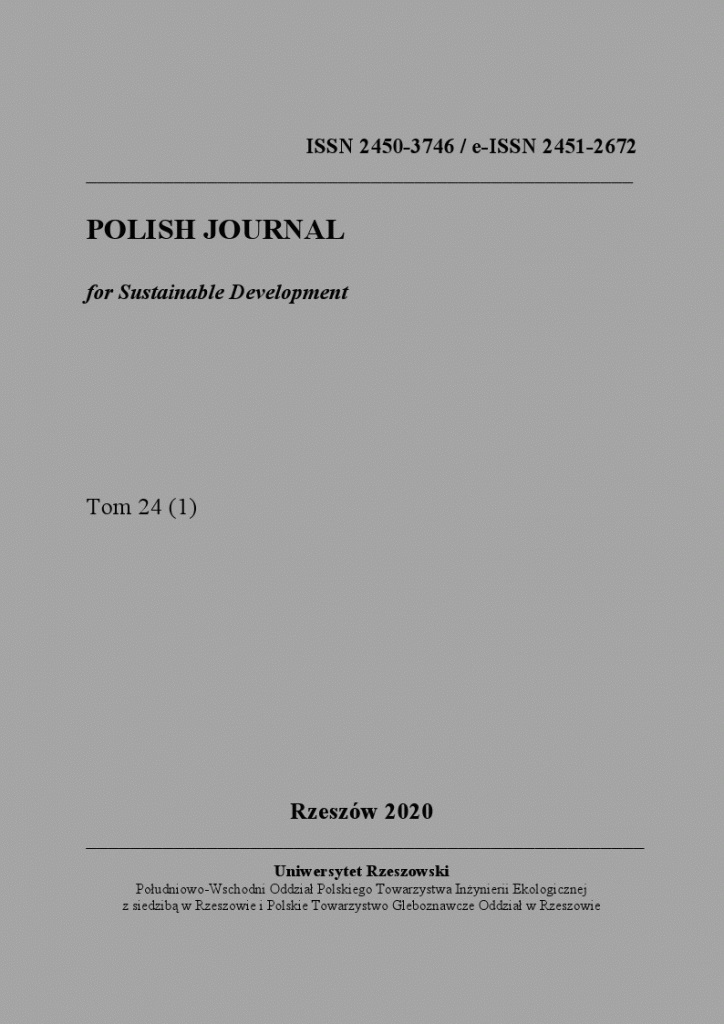Natural fertilization in the structure of fertilization in sustainable agriculture - on the example of Poland
DOI:
https://doi.org/10.15584/pjsd.2020.24.1.12Keywords:
natural fertilisation, mineral fertilisation, sustainable development of agriculture, PolandAbstract
The aim of this paper was to describe the state (as of 2010), structure by type (natural and mineral fertilisation, taking into account doses of nitrogen, potassium and phosphorus) and spatial diversification of fertilisation in the Polish agriculture (16 voivodships and 314 poviats). The studies of these issues concentrated on examining the impact of the external features of agriculture – natural and man-made ones. What has been demonstrated is the presence of a strong spatial diversification of fertilising procedures, mostly due to the impact of man-made conditions: historical and urban. It has transpired that the territorial patterns of fertilisation are bi-polar in nature: on the one hand, there are areas dominated by natural fertilisation (mostly north-eastern Poland); on the other hand, there are places where mineral fertilisation is prevalent (mostly northern and western Poland). Taking into consideration the planned Agricultural Census (2020) as well as the importance of pro-enviormental actions within The Common Agriculture Policy, the used metod of the comprehensive analysis of the feritilization for 2010 year constitutes a good starting point to the evaluation of the occurent changes.
Downloads
References
Baath E., Frostegard A., Pennanen T., Fritze H. 1995. Microbial community structure and pH response in relation to soil organic matter quality in wood-ash fertilized, clear-cut or burned coniferous forest soils. Soil Biology and Biochemistry. 27(2). 229-240.
Benton T.G., Vickery J.A., Wilson J.D. 2003. Farmland biodiversity: is habitat heterogeneity the key. Trends in Ecology and Evolution. 18. 182-188.
Brückner T. 1992. LPG – was nun? Agrarkonzentration im Osten Deutschlands. Die Neugestaltung des ländlichen Raumes. Internationalismus-Verlag. Hannover, Germany.
Buckley, D.H., Schmidt T.M. 2001. The structure of microbial communities in soil and the lasting impact of cultivation. Microbial Ecology. 42. 11-21.
Enwall K., Nyberg K., Bertilsson S., Cederlund H., Stenström J., Hallin S. 2007. Long-term impact of fertilization on activity and composition of bacterial communities and metabolic guilds in agricultural soil. Soil Biology & Biochemistry. 39. 106-115.
Fierer N., Jackson R.B. 2006. The diversity and biogeography of soil bacterial communities. Proceedings of the National Academy of Science of United States of America. 103. 626-631.
Gąsowski M. 2011. Nawożenie łąk i pastwisk nawozami naturalnymi. http://www.odr.pl/produkcja-roslinna/uzytki zielone/538/ (13.07.2011).
Grzebisz W. 2008. Nawożenie roślin uprawnych. Podstawy nawożenia. Powszechne Wydawnictwo Rolnicze i Leśne. Poznań. 146.
Jangid K., Williams M. A., Franzluebbers A. J., Sanderlin J. S., Reeves J. H., Jenkins M. B., Endale D. M., Colemann D. C., Whitman W. B. 2008. Relative impacts of land-use, management intensity and fertilization upon soil microbial community structure in agricultural systems. Soil Biology and Biochemistry. 40(11). 2843-2853.
Jezierska-Thöle A., Rudnicki R., Kluba M. 2016. Development of energy crops cultivation for biomass production in Poland. Renewable and Sustainable Energy Reviews. 62. 534-545.
Kagan A. 2011. Oddziaływanie rolnictwa na środowisko naturalne. Zagadnienia Ekonomiki Rolnej. 328 (3). 99-115.
Kleijn D., Sutherland W.J. 2003. How effective are European agri-environment schemes in conserving and promoting biodiversity? Journal of Applied Ecology. 40. 947-969.
Kostrowicki J. 1973. Zarys geografii rolnictwa. PWN. Warszawa.
Lalfakzuala R., Kayang H., Dkhar M.S. 2008. The effects of fertilizers on soil microbial components and chemical properties under leguminous cultivation. Am-Euras. Journal Agriculture Environ. Sci. 3. 314-324.
Mäder P., Fliessbach A., Dubois D., Gunst L., Fried P., Niggli U. 2002. Soil fertility and biodiversity in organic farming. Science. 296(5573). 1694-1697.
Melero S., Madejón E., Ruiz J. C., Herencia J. F. 2007. Chemical and biochemical properties of a clay soil under dryland agriculture system as affected by organic fertilization. European Journal of Agronomy. 26 (3). 327-334.
Rudnicki R. 2016. The spatial structure of Polish agriculture – conditioned by Common Agricultural Policy instruments. Wydawnictwo Naukowe UMK. Toruń.
Shaviv A. 2001. Advances in controlled-release fertilizers. Advances in agronomy. 71. 1-49.
Strategy Means of Agricultural Production. National Agricultural Census 2011. 2011. Central Statistical Office. Warsaw.
Triberti, L., Nastri, A., Giordani, G., Comellini, F., Baldoni, G., Toderi, G. 2008. Can mineral and organic fertilization help sequestrate carbon dioxide in cropland? European Journal of Agronomy. 29(1). 13-20.
Waloryzacja rolniczej przestrzeni produkcyjnej Polski. 2000. The Institute of Soil Science and Plant Cultivation. Puławy.
Witek T., Górski T. 1997. Przyrodnicza bonitacja rolniczej przestrzeni produkcyjnej w Polsce. The Institute of Soil Science and Plant Cultivation. Puławy.
Zalewski A. 2010. Rynek nawozów mineralnych w Polsce. Opinie i Ekspertyzy OE-133. Bureau of Analyses and Documentation by the Senate Chancellery. Warszawa.
Downloads
Published
Issue
Section
License
Copyright (c) 2020 Polish Journal for Sustainable Development

This work is licensed under a Creative Commons Attribution-NonCommercial-NoDerivatives 4.0 International License.


